Prenatal maternal depressive symptoms are associated with smaller amygdalar volumes of four-year-old children
Acosta H; Karlsson L; Lahdesmaki T; Tuulari JJ; Scheinin NM; Parkkola R; Hashempour N; Rajasilta O; Pelto J; Karlsson H; Lavonius TI; Saunavaara V
Prenatal maternal depressive symptoms are associated with smaller amygdalar volumes of four-year-old children
Acosta H
Karlsson L
Lahdesmaki T
Tuulari JJ
Scheinin NM
Parkkola R
Hashempour N
Rajasilta O
Pelto J
Karlsson H
Lavonius TI
Saunavaara V
ELSEVIER IRELAND LTD
Julkaisun pysyvä osoite on:
https://urn.fi/URN:NBN:fi-fe2021042822149
https://urn.fi/URN:NBN:fi-fe2021042822149
Tiivistelmä
Prenatal maternal depressive symptoms are related to an increased offspring susceptibility to psychiatric disorders over the life course. Alterations in fetal brain development might partly mediate this association. The relation of prenatal depressive symptoms with child's amygdalar volumes is still underexplored, and this study aimed to address this gap. We explored the association of prenatal maternal depressive symptoms with amygdalar volumes in 28 4-year-old children (14 female). Amygdalar volumes were assessed using the volBrain pipeline and manual segmentation. Prenatal depressive symptoms were self-reported by mothers at gestational weeks 14, 24 and 34 (Edinburgh Postnatal Depression Scale). Sex differences were probed, and possible pre- and postnatal confounders, such as maternal general anxiety, were controlled for. We observed that elevated depressive symptoms of the early second trimester, after controlling for prenatal maternal general anxiety, were significantly related to smaller right amygdalar volumes in the whole sample. Higher depressive symptoms of the third trimester were associated with significantly smaller right amygdalar volumes in boys compared to girls. Altogether, our data suggest that offspring limbic brain development might be affected by maternal depressive symptoms in early pregnancy, and might also be more vulnerable to depressive symptoms in late pregnancy in boys compared to girls.
Kokoelmat
- Rinnakkaistallenteet [19207]
